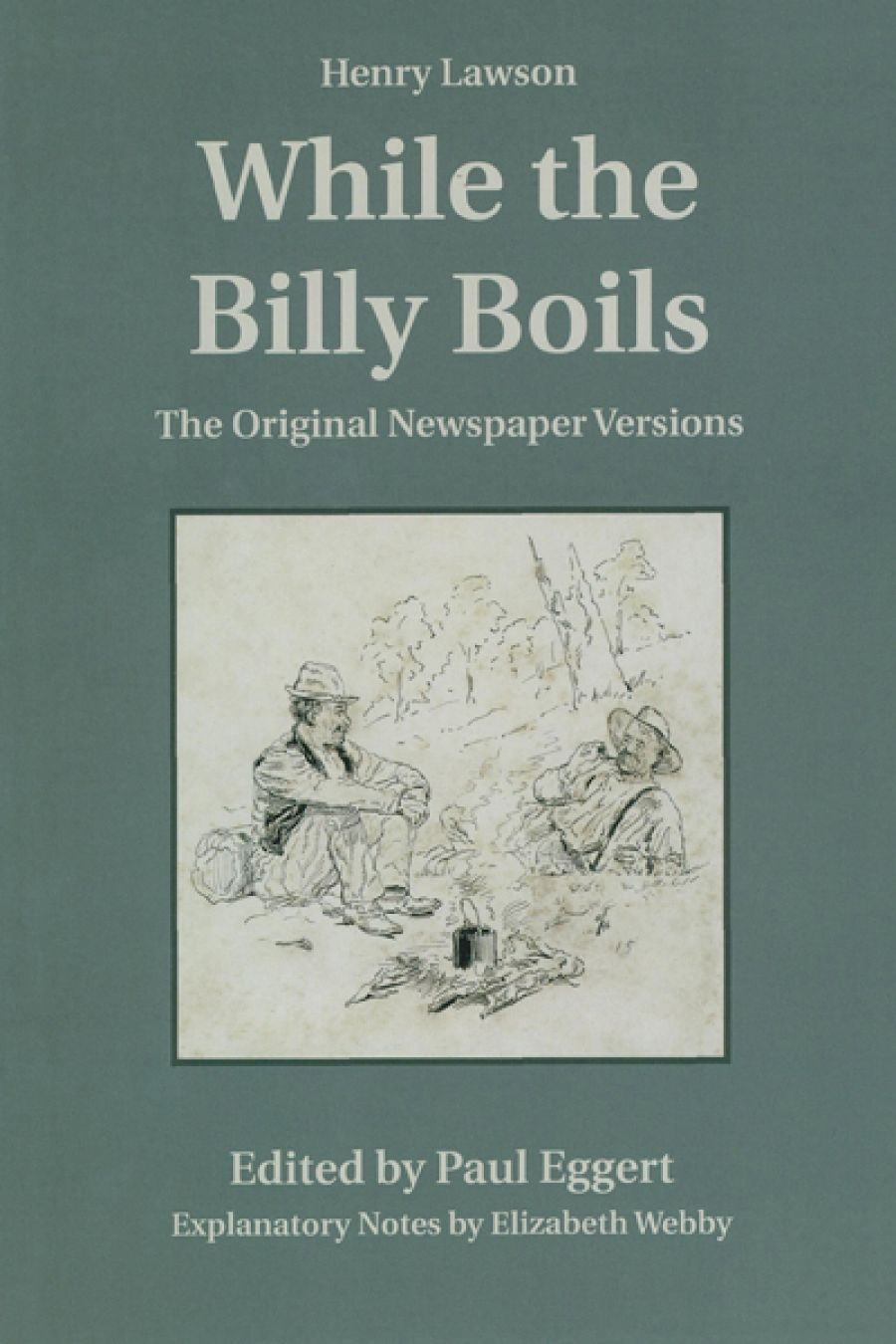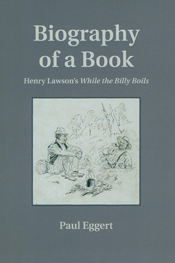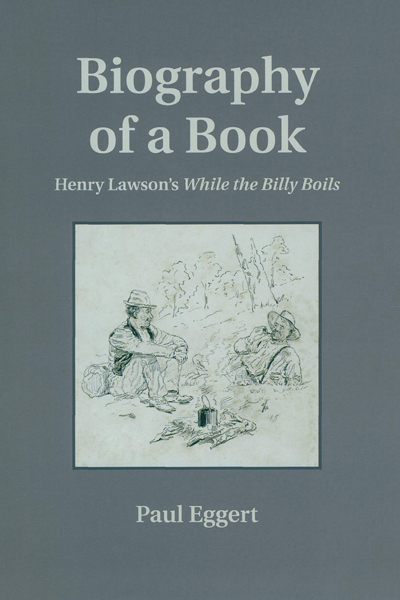
- Free Article: No
- Contents Category: Australian History
- Subheading: An indubitable classic of Australian literature
- Custom Article Title: Paul Brunton reviews 'While the Billy Boils' by Henry Lawson and 'Biography of a Book: Henry Lawson’s 'While the Billy Boils'' by Paul Eggert
- Review Article: Yes
- Article Title: Henry the dogged
- Online Only: No
- Custom Highlight Text:
It is not often that a truly ground-breaking work appears, publishers’ hype notwithstanding. Paul Eggert has produced two such works in the one year, which must be a record. Both relate to Henry Lawson (1867–1922), arguably the most famous Australian writer of all time.
- Book 1 Title: While the Billy Boils
- Book 1 Subtitle: The Original Newspaper Versions
- Book 1 Biblio: Sydney University Press, $30 hb, 448 pp, 9781743320112
- Book 1 Readings Link: booktopia.kh4ffx.net/bxXnx
- Book 2 Title: Biography of a Book
- Book 2 Subtitle: Henry Lawson’s 'While the Billy Boils'
- Book 2 Biblio: Sydney University Press/Pennsylvania State University Press, $40 hb, 415 pp, 9781743320143
- Book 2 Cover Small (400 x 600):

- Book 2 Cover (800 x 1200):

- Book 2 Cover Path (no longer required): images/stories/issues/354_September_2013/Biography-of-a-Book.jpg
While the Billy Boils is one of the indubitable classics of Australian literature – remarkably so, considering that it is a book of short stories. First published on 29 August 1896, it has been in print in various forms ever since. Lawson was twenty-nine when the book was published. He had by that stage endured an unhappy childhood, been afflicted with deafness, seen his parents separate, been persecuted as an oddity at school and at work, started on the road to alcoholism, and contracted a marriage that would collapse after six years. There was more to come: depression, poverty, jail (for non-payment of maintenance), attempted suicide, hospitalisation (for alcoholism and depression). He died at fifty-five, a wreck of a man. His creative period extended for only fifteen years.
Biography of a Book tells the engrossing and previously untold story of the making of Lawson’s classic book as well as the history of its continuing publication and reception. The idea that literary works have lives, and that the study of these lives can challenge previously held generalisations about literary works and periods, is relatively recent. Such studies use the sort of evidence found, for example, in previously neglected sources such as publishing archives. Biography of a Book is perhaps the first time this life-history approach has been applied to an Australian work.
While the Billy Boils consisted of fifty-two stories, all but two of which had been previously published in newspapers. The text was a collaborative effort – Lawson was not in sole control – and it is this collaboration which is so skilfully unwoven and dissected in Biography of a Book. Lawson had the opportunity to revise the stories before publication, and Arthur Wilberforce Jose, employed by the publisher, edited them. Lawson could disagree with this editing, but since the publisher, George Robertson of Angus & Robertson, was paying the piper, he would also be calling the tune. Lawson was not averse to this. He wanted a book, as did Robertson, that would make London sit up and take notice, and Jose edited accordingly.
Words and phrases were changed, added, or deleted; Australian vernacular expressions were toned down to spare the sensibilities of a British readership and in order not to frighten the reviewers. Spellings, which often were an important part of characterisation, were standardised; punctuation was changed, which altered the rhythm ofcertain passages; and devices such as inverted commas and capitalisation, which conveyed meaning, were removed. The texts of Lawson’s stories were corrupted and remained corrupted through numerous reprintings and editions until now.
Eggert takes us through the making of the book; not only the textual changes, but other relevant matters such as, for example, the commercial constraints which influenced the final product. A book had to be of a certain length; almost at the last minute, two extra stories had to be written. The final literary product is determined, more often than is admitted, by commercial considerations rather than by artistic sensibility. A study such as this at long last brings to the fore the significance of these market realities.
 Photograph of Henry Lawson taken in 1902. (Lawson Collection, Sydney University)
Photograph of Henry Lawson taken in 1902. (Lawson Collection, Sydney University)
Biography of a Book rewrites literary history. For example, the myth of the 1890s, the spuriousness of which has been adumbrated previously by others, but without the benefit of the empirical evidence which Eggert now brings to the table, is severely shaken. The 1890s, so the legend goes, saw the beginning of an authentically Australian literature, with Lawson a key figure and While the Billy Boils an iconic text. However, as Eggert writes, George Robertson had to devise a sales campaign that would capture the public’s attention. Playing the nationalist card – or, more precisely in this case, that of pride in local colonial achievement – was an obvious stratagem. Robertson was far more intent on the latter aspect than on the ideological relevance of Lawson’s stories to the Bushman experience outback … later interpreters of the 1890s mistook this sales pitch for a decisive swing in cultural temperament.
‘Critics who write of the nationalist ideology to be found in Lawson’s or other Bulletin writings are more likely identifying a 1950s view than one held in the 1890s.’
The cultural environment was much more varied than those later interpreters have assumed. The stocks of second-hand bookshops today and the extant catalogues of circulating libraries and literary institutes demonstrate the popularity of a host of non-Australian authors such as Dickens, Emerson, Twain, Trollope, and Kipling. ‘[N]o uniformly nationalist “imagined community” sprang into being, fully formed, in the 1890s. The contemporary readership was simply too divided in its tastes and diverted by its abundant sources of magazines and books for this to be the case.’
As for Lawson being central to this myth, Rolf Boldrewood’s Robbery under Arms (1888), for example, had far higher sales than While the Billy Boils. This was owing to its British publisher’s superior sales and distribution capacity. Here we see again the hard realities of the marketplace. Critics who write of the nationalist ideology to be found in Lawson’s or other Bulletin writings are more likely identifying a 1950s view than one held in the 1890s.
Eggert notes that the peak period for sales of Lawson’s works was actually after World War II, especially from the late 1950s until the end of the 1980s. In a beguiling statistic he tells us that this very period was exactly when income disparity in Australia was least. An egalitarian writer appeared to suit an egalitarian era.
 Henry Lawson, 1915. Photo by William Johnson (Mitchell Library, State Library of New South Wales)
Henry Lawson, 1915. Photo by William Johnson (Mitchell Library, State Library of New South Wales)
Accompanying Biography of a Book is a scholarly edition of While the Billy Boils, edited by Eggert with explanatory notes by Elizabeth Webby. Reading this was for me a revelation. The text of the stories as first printed in newspapers has been restored. ‘[T]he accretions, intentions and sequencing of the 1896 book’ are stripped away ‘rather than treating them as the inevitable climax of a literary revolution’. The changes to the text over the years are charted, and the reader is directed to the University of Sydney’s e-scholarship website or to the State Library of New South Wales’ website, where digitised images of the printer’s copy with its various changes, deletions, and additions may be scrutinised.
Each story is accompanied by extensive explanatory notes, which include glossaries explaining an Australian vernacular now almost lost. I do not know how many times I have read ‘The Bush Undertaker’, but I did not know until now that Brummy (the name of the drunk being buried) is an abbreviation of Brummagem, i.e. of Birmingham, and refers to cheap manufactured goods.
‘One of Lawson’s most admirable qualities was persistence.’
Because the stories are printed, as they previously have not been, in the order of first publication, the reader is able to appreciate Lawson’s development as a writer and the seminal influence of his 1892–93 visit to Bourke and the Darling. This was the first and only time he actually experienced the great Australian outback. The original publication obscured this by using an ordering which was governed by commercial considerations. Significantly, in view of the myth of the 1890s, it was the stories predating his visit to Bourke, which were most praised by contemporary reviewers, not those which later critics would consider encapsulated the nationalist thesis.
What would Lawson think about being accorded both a scholarly edition and a book-history? I do not think he would be surprised. Nor would he have been by the state funeral or the statue which was erected in 1931, or by the streets and places named after him, by the competitions and prizes in his name and the literary festivals, or by the fact that every place he ever lived, or passed through, has claimed him.One of Lawson’s most admirable qualities was persistence. He never gave up on himself, and he continued to write long after his use-by date in the hope of, again, coming good. As Biography of a Book makes clear, he took his writing very seriously indeed. The famous artlessness was the result of hard graft. He knew his texts had been mangled. But he knew it would all come right in the end, as indeed it has, thanks to Paul Eggert and Elizabeth Webby. No writer deserves such posthumous rehabilitation more than does Henry Lawson.
Professors Eggert and Webby, ‘you have done a big thing’, as Lawson said to Miles Franklin after reading the manuscript of My Brilliant Career. Two big things, actually.


Comments powered by CComment